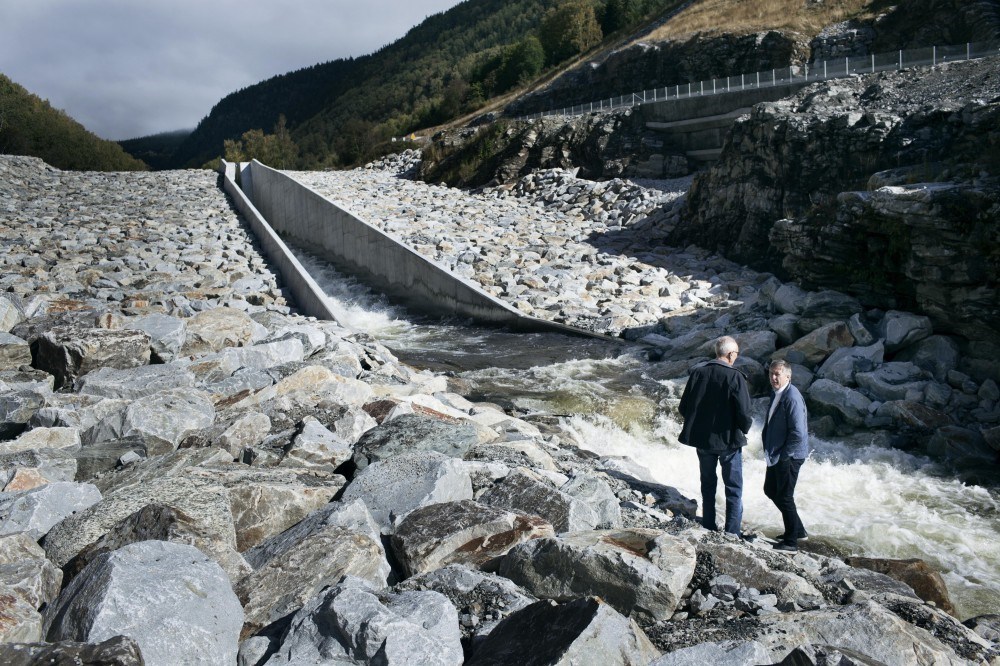No once-in-a-hundred-years floods ever again
When the small village of Kvam in Gudbrandsdalen was hit by two once-in-a-hundred-years floods in the space of three years, it unwittingly became a symbol of Norway’s vulnerability to extreme weather. Today the village boasts robust adaption solutions and has the best flood defences in Norway.
Climate change in Oppland
The county of Oppland has what is referred to as a continental climate with cold winters. Calculations indicate that temperatures will increase there by around four degrees and that annual precipitation will increase by approximately 20% by the end of this century. The intensity of the precipitation will increase on days when it rains heavily, and there will be more days with heavy precipitation. The temperature and the precipitation are calculated to increase the most in the winter.
Source: the Norwegian Centre for Climate Services (Norsk Klimaservicesenter)
“On 22 May 2013 I stood on the veranda here with tears in my eyes. I saw a big rock move down the Åa river towards the house next door and thought ‘oh dear, now the neighbours will have to move out again’. They had only just moved back in after the 2011 flood”, explains Judit Næprud from her sofa in her house on Åvegen in Kvam.
“I then suddenly saw a radio reporter running towards us shouting that we also had to get out of there. The river was about to head straight for our house”, she continues.
Judit and her husband Håkon escaped just in time. Minutes later, their house was hanging in mid-air above the raging river.
“Our house had been built onto our son’s house, and now it was only the nails holding it up. Our neighbour, who built it, has been very proud of exactly this fact since”, comments Håkon with a smile.
The cellar and half the plot lost
The Storåa river, which locals call simply the Åa, had been Judit and Håkon’s closest neighbour since they built their house in 1976. They had added a terrace that faced the river so they could sit and watch it flow by. The river could sometimes be a little boisterous, but the Næpruds just thought this was exciting. In 2011 they were given a foretaste of what the river was capable of when it carved itself a new path and destroyed the houses of a number of neighbours. Fortunately, this was thought to be a once-in-a-hundred-years flood, meaning that there is calculated to be a 1% chance of such an event happening in any single year.
But, less than two years later, the river broke its banks again. This time, it took an even bigger bite out of the residential area through which it flowed. Two of the three houses that had been rebuilt from the ground up following the 2011 flood were completely destroyed. The river washed the entirety of Judit and Håkon’s basement floor away in addition to half of their garden, in which Judit estimates she had between three and four thousand lilies.
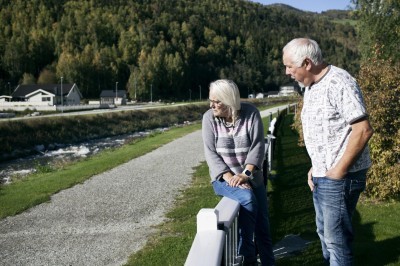
Nearest neighbour: Judit and Håkon Næprud surveying the Åa, which is usually a benign river. However, in 2013 it washed away the entirety of the basement floor of their house.
“Everything here had gone”, comments Judit, pointing to what is once again a well-kept garden.
“The cellar was totally emptied. We had just been to Ålesund and the freezer was full of fish – the entire neighbourhood smelt of fish”, she recalls.
Judit and Håkon scoured the neighbourhood with their neighbours for their belongings as soon as the river had calmed down. There was not much they could salvage, as the power of the river had destroyed most things. The only thing Judit could recognise was a football signed by a women’s team for which she had been the coach.
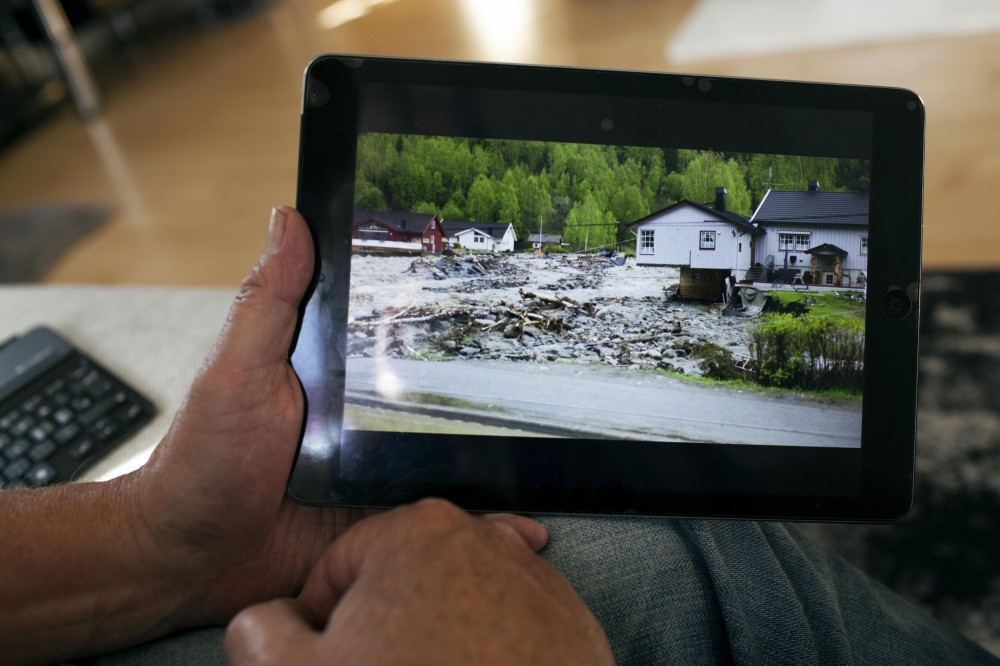 Painful memories: The Næpruds only just made it to safety before the deluge arrived in 2013.
Painful memories: The Næpruds only just made it to safety before the deluge arrived in 2013.
Debris flows are coming
Debris-flows
Debris-flows are high-velocity, flood-like landslides that move along defined channels and streams, including in channels where there is not normally water. The large amount of water they contain can dislodge and transport large quantities of loose material as well as big boulders, trees and other vegetation. Debris flows and debris slides are both types of landslide.
Source: The Norwegian Water Resources and Energy Directorate
It is not only the people who live along the Åa who remember 22 May 2013 well. Bjørn Bjørke, the Technical Operations Manager at Nord-Fron Municipality, thinks of that day as a powerful wake-up call.
“It had rained a lot, and at 10:00 a representative from the Norwegian Water Resources and Energy Directorate was out inspecting the river. He reported that everything seemed fine. Three hours later, the municipality’s crisis team had assembled”, he explains.
The municipalities in Gudbrandsdalen are used to dealing with meltwater floods, as they happen periodically. The lake in Gudbrandsdalen often bursts its banks when too much melt water flows off the mountain into it via small streams. But in recent years this traditionally quite dry area has had to get used to heavier rainfall creating debris flows, because the riverbeds of the streams have become blocked by debris that has slid down into them.
“Meltwater floods build up over time and we can check the water level in the river from one evening to the next. The two floods we had in 2011 and 2013 happened in the space of a few hours without any warning”, comments Bjørn Bjørke.
Another characteristic of the “new floods” is that they are more complex than the meltwater floods.
“In 2013 everything suddenly happened at once. Streams in a number of villages in the municipality overflowed, and the roads we needed to use for evacuation purposes collapsed. We had created an emergency response plan following the flood in 2011, but we couldn’t make much use of it. We had to react on instinct”, comments Bjørn Bjørke.
Since the second flood, the municipality has focused on practical emergency response training, which has included the entire emergency response team taking part in simulation exercises.
“We obviously cannot be prepared for everything, but we have realised that we need to be prepared for the fact that this type of event will happen more often”, comments Bjørn.
Kvam Municipality has a loan from KBN, which offers discounted green loans to municipalities seeking to invest in climate change adaptation measures, as well as in various other types of project.
“More and more places will be subjected to increased precipitation and extreme weather due to climate change. And, although adaptations to climate change can be expensive, the alternative may well be very trying for local communities. We want to help municipalities by reducing the cost through our green loans”, comments Lars Strøm Prestvik, KBN’s Chief Lending Officer.
Lars emphasises that it is important that municipalities take on the cost of adapting to changes to the climate BEFORE they happen.
“Only last week we saw examples of the challenges we are facing, with both the flood in Southern Norway and at Mannen mountain side, where everyone is expecting a landslide. People who live in areas threatened by landslides, floods and other natural disasters are affected by this, and we hope we can help more municipalities to deliver measures to adapt to the changing climate before the changes happen”, comments Lars Strøm Prestvik.
Better safe than sorry
As well as drilling the emergency response team, the municipality has put a lot of energy into preventing debris flows from being a problem at all in the future. The Norwegian Water Resources and Energy Directorate and the municipality have invested nearly NOK 120 million in a dam facility up in Veikledalen, the neighbouring valley that supplies the Åa river with water – and much debris. The dam has been built in accordance with a model that has been much used elsewhere, including in Germany, although it is the first of its kind in Norway.
“We have built a wall at the bottom of the valley below the side of the mountain from which most of the water and debris flow down to stop the debris. There is a 40 cm-wide vertical slot in the wall that allows just the water to flow out in a controlled fashion, leaving the mud and stones behind. From here the water is led down a ‘staircase’, which is an energy killer that causes the water to lose most of its energy”, explains Bjørn Bjørke.
The dam facility can hold back around 100,000 m3 of debris. An echo sounder at the mouth measures the water level and how quickly it is rising, and automatically alerts the municipality’s emergency number if abnormal values are recorded.
A little further down the river a smaller dam facility has been built to dam debris from a small side tributary that flows into the Åa. The riverbed has also been made wider and deeper where the river flows through central Kvam to help ensure that the water stays in place even when there is more water in it than usual.
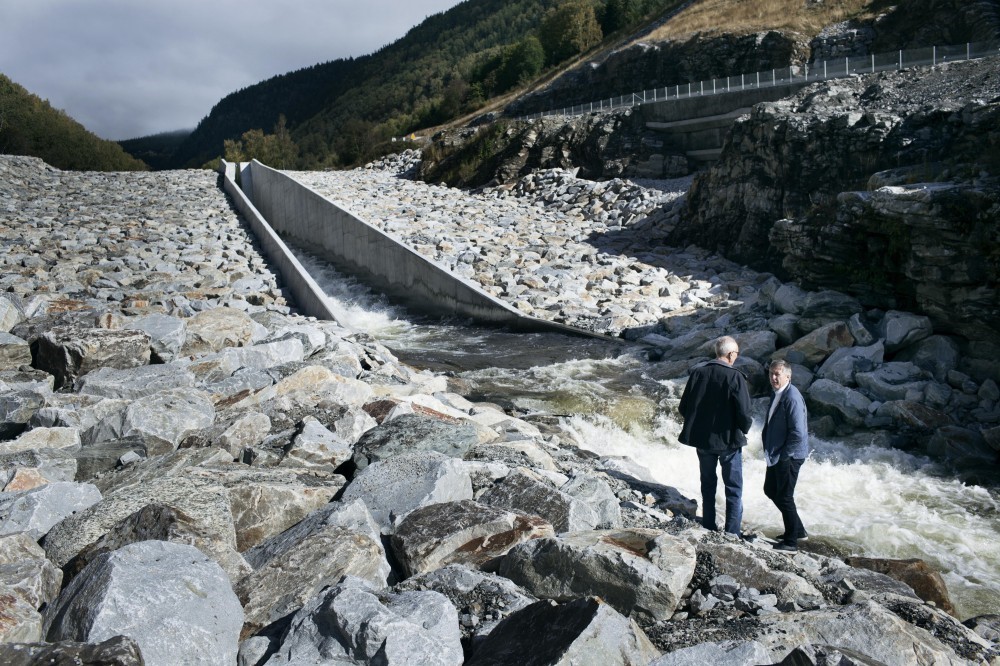 Ready this spring: When the rain was at its worst in July this summer, and Sør-Fron Municipality experienced major flooding, the new dam facility in Nord-Fron Municipality took the strain. Here Technical Operations Manager Bjørne Bjørke (on the left) and Mayor Rune Støstad inspect the facility.
Ready this spring: When the rain was at its worst in July this summer, and Sør-Fron Municipality experienced major flooding, the new dam facility in Nord-Fron Municipality took the strain. Here Technical Operations Manager Bjørne Bjørke (on the left) and Mayor Rune Støstad inspect the facility.
An additional bonus is that the dams, particularly the larger of the two, are nice to look at. The chute that leads the water out of the dam has a crisp architectural form that contrasts with the wooded hillside behind it. The municipality is working on installing LED lighting that will strengthen the impression of running water, and they hope to find the funds needed to build a viewing platform from which visitors can study the dam and look at plans and information about the flood and defences.
“In 2011 and 2013, people from across Norway came to see the destruction in Kvam. We now hope that people will come from across Europe to see how well we have protected the village”, comments Bjørn Bjørke.
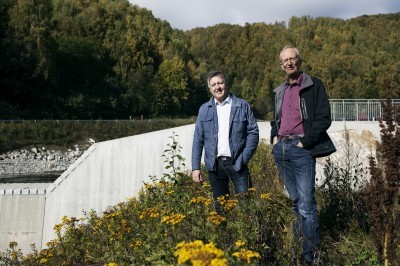
Protection for the village: Støstad (on the left) and Bjørke think that they now have the best flood defences is Norway.
Complex reconstruction
Rebuilding a village after this type of natural disaster is a bit of a jigsaw puzzle – and is expensive. Funds from the Ministry of Local Government and Modernisation covered the reconstruction of uninsurable assets such as municipal roads and water and wastewater systems. The bill for this came to NOK 120 million for Kvam in 2013. In addition to this were the insurance pay-outs received by private individuals for damage to homes and cars, for example. The Norwegian Public Roads Administration is responsible for re-building the county roads, while the Norwegian Water Resources and Energy Directorate is taking responsibility and paying the majority of the cost of the flood defence projects.
Bjørn Bjørke does not hide the fact that reconciling the wishes and needs of the municipality and the village with the rules and requirements of specialist public sector agencies has sometimes been challenging.
“We are pretty used to them coming here with set ideas explaining how things were going to be done without always taking the time to listen to our proposals. That said, however, we are really pleased with the flood defences we now have, and the most important thing is that people in the village are safe”, he comments.
“Moreover, there was in a way something fortunate about the fact that we were unlucky enough to have been affected by debris slides as early as we were, as it has meant that we have got robust flood defences for relatively little. 90% of the costs of the big dam and 95% of the costs of the small dam were paid for us, despite the municipality in theory having to pay an excess of 20%. It seems as though lots of people were feeling sorry for us at the time!” comments Bjørn Bjørke.
“However, since then many other villages have experienced similar crises”, he comments.
Difficult prohibition on builiding
Work on the flood defences started following the 2013 flood, and was completed on 31 March this year. It was a long-awaited date both for Kvam’s residents and for the municipality’s management team. The municipality found itself obliged to follow the Norwegian Water Resources and Energy Directorate’s recommendation that a prohibition against construction and planning approval should be imposed in areas affected by the flood until such time as the defences were in place. This meant that people whose houses were destroyed were unable to start rebuilding them until this spring. The municipality offered new plots in a safe area to the people affected by this, but many chose to wait in order to return to their own plot.
“We very much understand that the prohibition against building has been difficult for people”, comments Rune Støstad (Labour), the Mayor in Nord-Fron.
“Having your house flooded, maybe even twice, and then not being allowed to rebuild it – this has obviously been a strain. But we have followed the Norwegian Water Resources and Energy Directorate’s clear instructions. We did not want to put people in danger of suffering the same thing again before the defences were in place. I would like to thank those who were affected by the flood for the patience they have shown”, he comments.
Unity and community spirit
The Mayor is very satisfied with the flood defences that both protect the village against new debris flows and make residents feel safe. He praises Kvam’s residents for the way in which they dealt with the flood, but also for the unity and community spirit that meant that the village rose again in a short space of time.
“Both the evacuation and the rebuilding of Kvam are the result of residents, the voluntary sector, industry and the public sector all working together very successfully. Voluntary organisations such as the local branch of the Norwegian Women’s Public Health Association, the Red Cross and the village’s sports club were enormously important. The community in Kvam also deserves praise. I think that Kvam could be a model for other local communities that suffer crises”, comments Mayor Støstad.
The Næpruds find that their experience matches with the description provided by the Mayor.
“We have such good neighbours, people here are so good at taking care of each other”, comments Judit, who is not originally from Kvam.
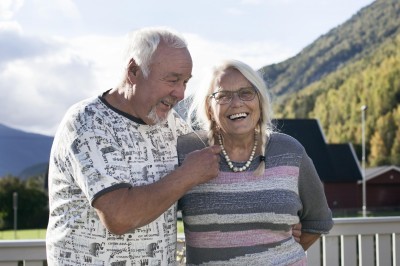
Garden restored: Judit and Håkon are currently borrowing their son’s house on the same plot while their new house is rebuilt, albeit further from the river.
